Intel SSD 520 Review: Cherryville Brings Reliability to SandForce
by Anand Lal Shimpi on February 6, 2012 11:00 AM ESTAnandTech Storage Bench 2011
Last year we introduced our AnandTech Storage Bench, a suite of benchmarks that took traces of real OS/application usage and played them back in a repeatable manner. I assembled the traces myself out of frustration with the majority of what we have today in terms of SSD benchmarks.
Although the AnandTech Storage Bench tests did a good job of characterizing SSD performance, they weren't stressful enough. All of the tests performed less than 10GB of reads/writes and typically involved only 4GB of writes specifically. That's not even enough exceed the spare area on most SSDs. Most canned SSD benchmarks don't even come close to writing a single gigabyte of data, but that doesn't mean that simply writing 4GB is acceptable.
Originally I kept the benchmarks short enough that they wouldn't be a burden to run (~30 minutes) but long enough that they were representative of what a power user might do with their system.
Not too long ago I tweeted that I had created what I referred to as the Mother of All SSD Benchmarks (MOASB). Rather than only writing 4GB of data to the drive, this benchmark writes 106.32GB. It's the load you'd put on a drive after nearly two weeks of constant usage. And it takes a *long* time to run.
1) The MOASB, officially called AnandTech Storage Bench 2011 - Heavy Workload, mainly focuses on the times when your I/O activity is the highest. There is a lot of downloading and application installing that happens during the course of this test. My thinking was that it's during application installs, file copies, downloading and multitasking with all of this that you can really notice performance differences between drives.
2) I tried to cover as many bases as possible with the software I incorporated into this test. There's a lot of photo editing in Photoshop, HTML editing in Dreamweaver, web browsing, game playing/level loading (Starcraft II & WoW are both a part of the test) as well as general use stuff (application installing, virus scanning). I included a large amount of email downloading, document creation and editing as well. To top it all off I even use Visual Studio 2008 to build Chromium during the test.
The test has 2,168,893 read operations and 1,783,447 write operations. The IO breakdown is as follows:
| AnandTech Storage Bench 2011 - Heavy Workload IO Breakdown | ||||
| IO Size | % of Total | |||
| 4KB | 28% | |||
| 16KB | 10% | |||
| 32KB | 10% | |||
| 64KB | 4% | |||
Only 42% of all operations are sequential, the rest range from pseudo to fully random (with most falling in the pseudo-random category). Average queue depth is 4.625 IOs, with 59% of operations taking place in an IO queue of 1.
Many of you have asked for a better way to really characterize performance. Simply looking at IOPS doesn't really say much. As a result I'm going to be presenting Storage Bench 2011 data in a slightly different way. We'll have performance represented as Average MB/s, with higher numbers being better. At the same time I'll be reporting how long the SSD was busy while running this test. These disk busy graphs will show you exactly how much time was shaved off by using a faster drive vs. a slower one during the course of this test. Finally, I will also break out performance into reads, writes and combined. The reason I do this is to help balance out the fact that this test is unusually write intensive, which can often hide the benefits of a drive with good read performance.
There's also a new light workload for 2011. This is a far more reasonable, typical every day use case benchmark. Lots of web browsing, photo editing (but with a greater focus on photo consumption), video playback as well as some application installs and gaming. This test isn't nearly as write intensive as the MOASB but it's still multiple times more write intensive than what we were running last year.
As always I don't believe that these two benchmarks alone are enough to characterize the performance of a drive, but hopefully along with the rest of our tests they will help provide a better idea.
The testbed for Storage Bench 2011 has changed as well. We're now using a Sandy Bridge platform with full 6Gbps support for these tests.
AnandTech Storage Bench 2011 - Heavy Workload
We'll start out by looking at average data rate throughout our new heavy workload test:
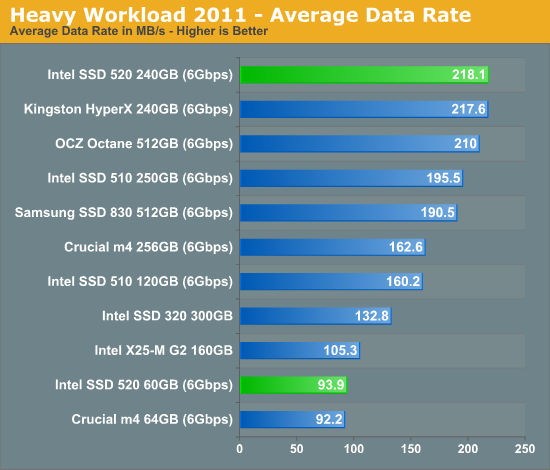
SandForce has always done well in our Heavy Workload test, and the 520 is no different. For heavy multitasking workloads, the 520 is the fastest SSD money can buy. Note that its only hindrance is incompressible write speed, which we do get a hint of in our breakdown of read/write performance below.

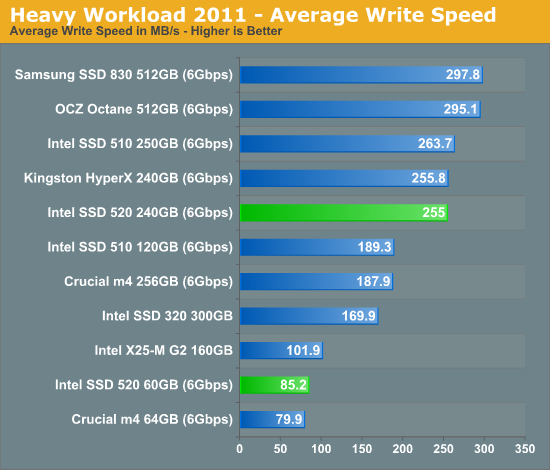
The next three charts just represent the same data, but in a different manner. Instead of looking at average data rate, we're looking at how long the disk was busy for during this entire test. Note that disk busy time excludes any and all idles, this is just how long the SSD was busy doing something:
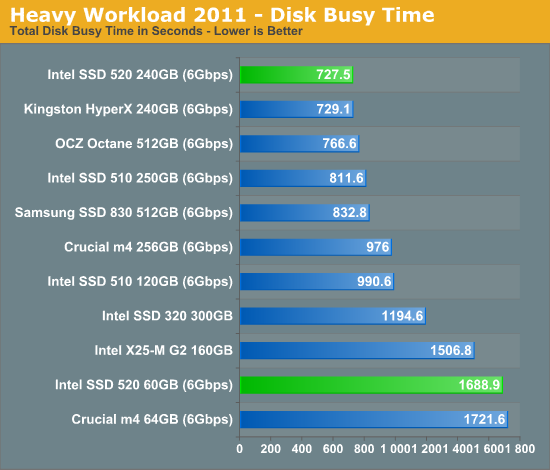
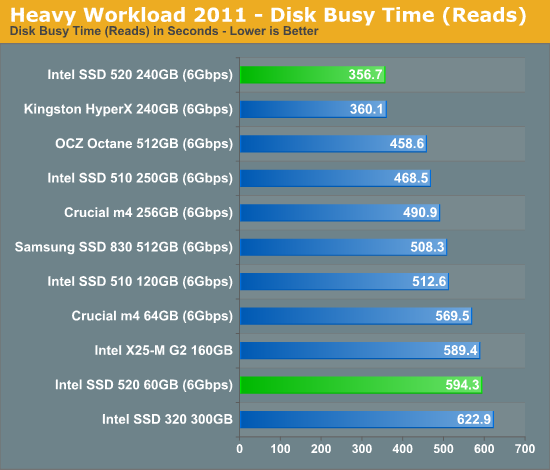
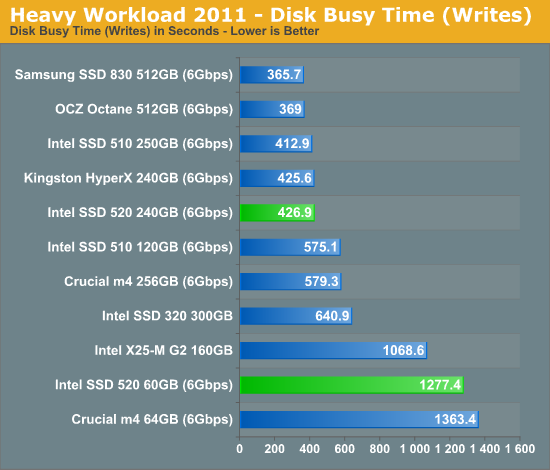










138 Comments
View All Comments
vanteo - Thursday, May 31, 2012 - link
I got a 520 120 GB for my Lenovo W520 a week ago ($187). I experienced a few freezes (mouse still movable but the HD light stuck on and I couldn't actually DO anything), and long stutters (5 sec < n < 1 min) while setting it up shortly after Windows 7 64-bit install. It came with the 400i firmware, which was still the latest. As I used it more, the freezes have stopped and the stutters seem to have all but disappeared. I did install Intel's latest Rapid Storage Technology drivers at some point, so perhaps that helped. Otherwise, very fast and I'm pleased.vanteo - Thursday, May 31, 2012 - link
I should clarify that the problems were during normal operation. They had nothing to do with hibernate, standby, or resume.vanteo - Thursday, August 23, 2012 - link
Update: I'm still running into these hangs regularly, actually. I followed some advice to change some advanced Hard disk power options (LMP), but that had no effect. Either it's a bad drive, or there's some system incompatibility with the Lenovo ThinkPad W520.kzinti - Thursday, May 31, 2012 - link
Just following up on my April 18 post... I am still running the replaced 520 SSD as my OS and everything runs smoothly. Haven't run into a single BSOD or hiccup / slowdown. I use my computer 4h+ a day.jfgreen - Monday, September 17, 2012 - link
This drive has some serious issues this was my post in Intel Support Community:Last Thursday I received my brand new Dell Precision M6600. Before I started to use the system I upgraded the hard drive to an Intel 520 Series..
After dropping in the SSD, I was ready to install Windows 7 Pro. I first went into the BIOS and left the setting on RAID. After reading tons of forums, this seemed like the right way on installing the hard drive. Once complete I installed all the necessary drivers (which is a story in its self!). After, I went on the Intel website and ran the driver utility make sure everything is up-to-date. I also installed the SSD toolbox to optimize the drive.
After dealing with the BIOS not always detecting the SSD and the occasional OS freeze, I made my way into the Intel control panel. I noticed the hard drive was only running at 3GB/s, I thought that was kind of odd since the computer is capable of running 6GB/s. I decided to change the BIOS to AHCI and reinstall 7..
Once complete, I still had to deal with the BIOS not detecting the SSD and 7 freezing up, every so often. Anywho, once I re-installed all drivers and utilities. I now see the hard drive running at 6GB/s. I was a happy camper until I started to use the computer. I noticed it freezed up the more I use it.
Intel (typing this while simultaneously shaking my pointer finger) you have a serious issue with your SSD. You need to post a firmware update. Not only to fix the issue with 7 but, also for folks who have M6600 and other affected laptop/desktops; who decide to buy your SSD.
nextel2010 - Saturday, September 29, 2012 - link
I hear you. I purchased three Intel 520's and installed them in three systems known to be stable. One works well, one had intermittent freezes, and the last would freeze and BSOD several times a day, regularly. This last one also had problems being recognized by the BIOS during installation, and would intermittently drop off the system afterwards.I researched the issue, and found a whole lot of suggested fixes, but no general patterns to a solution. In an effort to troubleshoot the last system, I replaced the 520 with an old OCZ Core II, purchased in early 2009. The OCZ was recognized immediately by the BIOS, and installed easily. It ran perfectly, if a bit slower, up to the present time (more than a month).
i don't have time to troubleshoot the two nonworking systems, which are mission-critical and needed to be operational, so I returned the two troublesome 520's and replaced them with Samsung 830's. The Samsungs are lifesavers. They work perfectly, are every bit as fast as the Intels and, most importantly, are rock stable. I couldn't be happier with them or recommend them more. Adding even more value is the fact that the Samsungs were less expensive than the 520's.
I initially went with the Intel because of their five-year warranty and reputation for reliability, but to me at least, it doesn't appear that they have been able to iron out the issues with the SF-2281. To date, no firmware update had been released. A longer warranty for a troublesome drive is pointless. A lot of users have had no issues with the 520's, but a good number still encounter problems. If it was my own system and time wasn't an issue, I wouldn't mind tinkering and troubleshooting, but under the circumstances, I simply went with the solution that works.
toncij - Sunday, September 30, 2012 - link
It is a nice review, but what bothers me is:"Intel did go on record saying that the 520 is expected to have far fewer F4/F7 BSODs than any other SF-2281 drive. I asked Intel if I should read into the phrase "far fewer", but the answer was no - the 520 is expected to have similar reliability to the Intel SSD 510 and 320."
Since I've experienced 320 series and would never go back there, I wonder why intel avoids to say "NO BSODs" - I'm not particullary fond of "far fewer BSOD's" and I prefer zero of those.
I'm looking for the best SSD I can get, but with stability and reliability being a primary variable to look at. I've noticed people praise SM 830 drivers, but these seem much slower than 520 and still quite power-hungry at idle and load, which pretty much is not what I'd like to put into my ultraportable.
Is Intel still prone to BSODs and how good it really is compared to SM830?
sarangiman - Friday, October 12, 2012 - link
Not sure why this article mentions that the 480GB drive is only available with a 9.5mm chassis.If you remove the black spacer, it's 7mm (well, 6.5mm as measured by my caliper).
Albeit, I just bought the drive this week (10.2012); was this 480GB drive originally 9.5mm but now they're shipping 7mm chassis + black spacer?
If one could find short screws for the 7mm chassis, I don't see why one couldn't use the 480GB drive in form factors requiring 7mm drives...